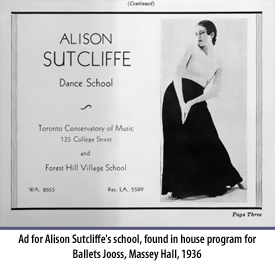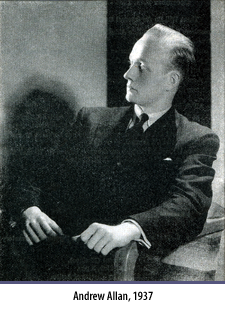| |||||||

![]()
 Speaking of German Expressionists, Sutcliffe was able to see both Harald Kreutzberg and the Jooss European Ballet perform in February and March of 1936. She made a point of advertising her classes in the house programs for these performances; in the ads, she strikes a very modernist pose. She also managed to get Kreutzberg to autograph her program. Sutcliffe studied with Jooss again in the summer of 1936.
Speaking of German Expressionists, Sutcliffe was able to see both Harald Kreutzberg and the Jooss European Ballet perform in February and March of 1936. She made a point of advertising her classes in the house programs for these performances; in the ads, she strikes a very modernist pose. She also managed to get Kreutzberg to autograph her program. Sutcliffe studied with Jooss again in the summer of 1936.
The Bridge of the Pink Cloud by Olive Price kept Sutcliffe busy in the fall of 1936. A Toronto Children Players' production that was performed in October, the play required Sutcliffe to choreograph Japanese-styled dances. The tropics was the theme for her next event. The Heliconian Club held a Christmas party for its members in December during which Sutcliffe, Lorna Sheard and Bunny Lang performed a tropical bird number to the sounds of a tom tom drum and reed pipes played by musicians Kathleen Irwin and Betty Maaw. Evelyn VanValkenburg, Jane Mallett and others danced a Zulu-themed piece to music played by Winnifred Mazzoleni.
Sutcliffe, Sheard and Lang joined up with Mallet and Fred Manning in a Town Tonics show on March 6, 1937. Also on board was musician Kathleen Irwin. Mallett and Manning had started their satiric revue in 1934 and continued to delight audiences with their comedy for the next decade. Performed at Hart House Theatre, this particular rendition drew a capacity crowd. Mallett and Manning presented a variety of skits, some original and others by the popular humourists of the day such as Dorothy Parker and Noel Coward. Dancers Sutcliffe, Sheard and Lang performed in the "African Triangle" sketch described in the house program as "A travel talk on the home life of the natives". Choreographed by Sutcliffe, The Toronto Daily Star's Augustus Bridle described it as "a zoological satire on love and deception. A curiously disconcerting comment on the jungle 'going civilized,'..." Rose Macdonald of The Telegram wrote, "... it was one of the nicest lampoons of the interpretive dance in its serious aspects that has been seen here in a long time." The production was directed by Dorothy Goulding.
 Prior to this show, Sutcliffe had choreographed the chorus line for a Junior League charity cabaret at Eaton Auditorium, and she had done the choreography for Andrew Allan's adaptation of Hans Christian Andersen's The Snow Queen at Hart House. This was another ambitious Christmas production at Hart House directed by Nancy Pyper. Pyper stepped into the directorship at Hart House in 1935 following a year of guest directors after Edgar Stone had moved on. She is the last director before a significant shift in the theatre's history; when she left in 1937, the theatre operated as a rental venue and was used more by faculty and student groups. Pyper was originally from Ireland and had been associated with the Abbey Theatre - a role model for other fledgling nationalist theatre scenes. She later became director of the drama program at the esteemed private girls' school, Bishop Strachan School.
Prior to this show, Sutcliffe had choreographed the chorus line for a Junior League charity cabaret at Eaton Auditorium, and she had done the choreography for Andrew Allan's adaptation of Hans Christian Andersen's The Snow Queen at Hart House. This was another ambitious Christmas production at Hart House directed by Nancy Pyper. Pyper stepped into the directorship at Hart House in 1935 following a year of guest directors after Edgar Stone had moved on. She is the last director before a significant shift in the theatre's history; when she left in 1937, the theatre operated as a rental venue and was used more by faculty and student groups. Pyper was originally from Ireland and had been associated with the Abbey Theatre - a role model for other fledgling nationalist theatre scenes. She later became director of the drama program at the esteemed private girls' school, Bishop Strachan School.
Andrew Allan, who dramatized the story, was an actor, writer, director and producer who later played a significant role in the development of Canadian radio drama. His radio show, Stage, produced plays by Canadian writers such as Lister Sinclair and Mavor Moore and gave opportunities to actors such as Lorne Greene, Lloyd Bochner, Jane Mallett and John Drainie. In the 1960s he became the first artistic director of the Shaw Festival in Niagara-on-the-Lake, Ontario.
Lorna Sheard had returned to Toronto from Montreal by 1937 and played the title role in Allan and Pyper's Snow Queen production. The roles of Gerda and Kay were played by and , and the role of Hans (Kay's friend) by Murray Davis; all three came from Josephine Barrington's Juveniles. The entire cast consisted of roughly sixty people including approximately twenty-five children.
 Sutcliffe choreographed and directed all of the dancing beginning with "The Demon's Dance" following the prologue. Scene IV consisted of a ballet titled "The Road to the Arctic Night", which presumably takes place after the Snow Queen has abducted Kay. The "Flower" characters in "The Magic Garden" scene also danced; the dancers were students of Sutcliffe's including Bettina Byers and Gladys Schnick. The same group also danced in the royal palace scene, and Byers danced in "The Robber's Castle" scene.
Sutcliffe choreographed and directed all of the dancing beginning with "The Demon's Dance" following the prologue. Scene IV consisted of a ballet titled "The Road to the Arctic Night", which presumably takes place after the Snow Queen has abducted Kay. The "Flower" characters in "The Magic Garden" scene also danced; the dancers were students of Sutcliffe's including Bettina Byers and Gladys Schnick. The same group also danced in the royal palace scene, and Byers danced in "The Robber's Castle" scene.
The production's costumes and fifteen sets were designed by Eric Aldwinkle who was a graphic designer, a member of the Arts and Letters Club and a teacher at the Ontario College of Art. He designed other productions for Hart House and then became a part of the war artist program during World War II.
In May of 1937, Sutcliffe presented her annual recital and several critics noted the higher quality of both the dancing and choreography. The writers, such as Lawrence Mason and Augustus Bridle, made a point of assuming that Sutcliffe's summer studies in Europe and England contributed to the overall change in quality. Over sixty students performed and this time two of her senior students, Bettina Byers and Estelle Cohen, choreographed one of the pieces - Sailor's Holiday. Sutcliffe highlighted her male students in a piece called Sport Rhythms. Other dances praised by the critics were In Titania's Garden, York Pioneers and First Scene from "The Life of Toys" set to Claude Debussy's music.
![]()
©2008, Dance Collection Danse
Alison Sutcliffe Exhibition Curator: Amy Bowring
Web Design: Believe It Design Works
The Snow Queen, 1937/38
Hart House production of The Snow Queen, 1937/38
Lorna Sheard in the title role of The Snow Queen, 1937/38




